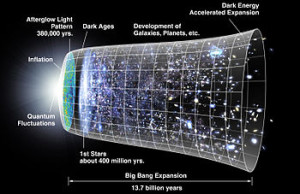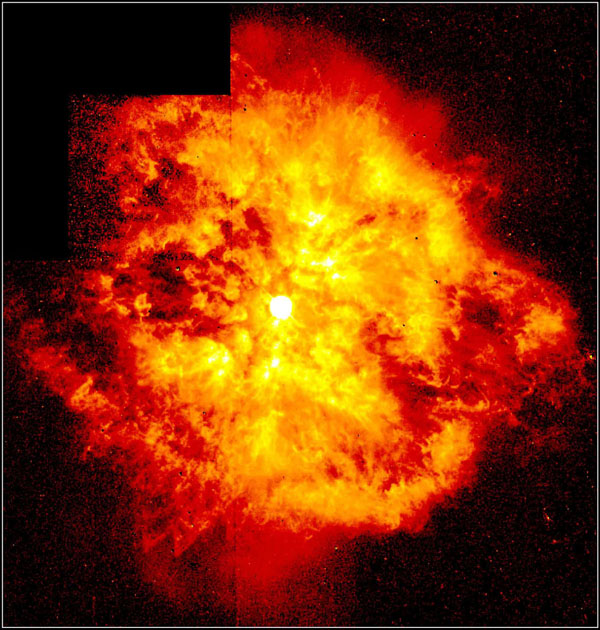The standard model of the Big Bang Theory can be explained in the following eight steps:
1. Before the Big Bang: Before space and time existed, the entity of the Universe was compressed into a singularity called space-time singularity. This singularity is a location where the quantities that are used to measure the gravitational field become infinite in a way that does not depend on the co-ordinate system.
2. The Big Bang: The creation process of the Universe began with an expansion, not an explosion as name suggests. The General Theory of Relativity yields an infinite density and temperature at a finite time in the past. The singularity breakdown the general relativity.
3. The inflationary epoch: The Big Bang happened everywhere, space itself was created in the Big Bang. The big bang is the beginning of time. We know that the Planck epoch is the shortest amount of time that we can probe in the laboratory with our current knowledge of Physics. The Plank epoch is the earliest moment in the history of the Universe form where our Physics works.
- During the first
the four forces were united. Temperature was
.
- The time
defines the time when gravity splits from other forces. We don’t have physical model for the first
. During
to
, forces were in combined form.
- There was a fundamental symmetry before gravity splits.
- Due to this split, fundamental symmetry broke. The breaking of fundamental symmetry in the early universe lead ‘inflation’.
- Before the inflation, universe was filled homogeneously and isotropically with an incredibly high energy density, huge temperatures and pressures and was very rapidly expanding and cooling. This high energy density correspond to the ‘zero point energy’ of the ‘quantum field’.

- This energy density lead to inflation, a strongly accelerated (inflation) expansion, which dilute irregularities and drive the density very close to the critical value.
- Universe grew exponentially during the inflation. It lasted for
after the Big Bang between
to
. The universe grew
times in volume.
- During the inflation, high energy photons collided to produce particle-antiparticle pairs, which then annihilated and produced energetic photons.
- As the universe expanded, the density and temperature decreased. Photon energy becomes too small to maintain this equilibrium of creation and annihilation.
- During the inflation universe was expanding much faster than the speed of light during the process of creation and annihilation. The rate of inflation of the universe was assumed to be doubling every
.
- At he end of the inflation, strong force splitted from the electroweak force.
4. Nano seconds after the Big Bang (quark gluon plasma)
- After inflation stopped, universe consisted of a ‘Quark gluon’ plasma as well as all other elementary particles.
- At this point, universe was in a ionized plasma state with radiation and matter inseparable. There was equal amounts of particles and antiparticles.
- Temperature were so high
that the random motion of particles were at relativistic speeds and particle-antiparticle pairs of all kinds were being continuously created and destroyed in collisions.
- As the temperature fell below
an unknown reaction called Baryogenesis violated the conservation of Baryon number, leading to a very small excess of quarks over antiquarks of the order of one part in 30 million.
- Due to this spontaneous symmetry breaking, the quark were slightly more in number. This resulted in the predominance of matter over antimatter in the present universe.
- There is a threshold temperature below which particles of a given type are no longer produced and annihilated. For example, the threshold temperature for hadrons (protons, neutrons and measons) is
reached at the time
of the big bang.
- At about
, quark and gluons combines to form baryons such as protons and neutrons.
- The small excess of quarks over antiquarks led to a small excess of baryons over antibaryons.
- The temperature was now no longer high enough
to create proton-antiproton or neutron-antineutron pairs. [A similar process happened for electrons and positrons at about 1 second.]
- However at this temperature, leptons and antileptons were perfectly annihilated.
- At the end of hadronic era, week force split from electro-weak force.
5. Between millisecond to a second after the Big Bang (Leptogenesis / Neutrino decoupling)
- As the temperature fell around
, the density of universe drastically reduced (in order to remove saddle points) called density fluctuation. Because of this neutrons start/begin to interact with matter (mostly baryons and mesons) effectively.
- Due to this interactions, these decouples neutrinos formed a universal gas within the universe.
- Because of the expansion of the space this gas has cooled to a temperature of 2K today. However, until today, it has not been possible to detect this universal background of neutrinos.
- Leptogenesis took place because of density fluctuation.
- Immediately after this, the annihilation of electron-positron pairs removed all positrons and most electrons. Thus, some of the electrons were left after decoupling neutrinos. This era is named as lepton era.
6. 100 seconds after the Big Bang (Nucleosynthesis)
- As the temperature fell to
protons and neutrons slowed down enough to allow nucleosynthesis to take place. At this temperature, protons, neutrons and electrons were no longer moving relativistically.
- However, the energy density of the universe was dominated by photons (with a minor contribution of neutrinos).
- During the period, atomic nuclei of Helium were produced as two protons and neutrons bonded. For every Helium nucleus formed, there were about 10 protons left behind allowing 25% of the universe to be comprised of Helium.
- Other than Helium nuclei,
,
and
were produced during the big bang nucleosynthesis.
7. 30 minutes after the Big Bang
- The energy density of photon increased through the annihilation of electron positron pairs.
- Less number of floating electrons were survived in the huge environment of photons.
- The energy of electron is decreased and coupled with hadrons.
- The first hydrogen atom is produced in this era.
8. 300,000 years after the Big Bang
- As the universe cooled, the rest mass energy density of matter come to gravitationally dominate that of the photon.
- Universe continued to expand and cool, reached to a temperature of 10,000 K. It allowed Helium nuclei to absorb free floating electrons to form Helium atoms. Also Hydrogen atoms were bonding together to form lithium atom.
- As the temperature reached to 4000 K, Hydrogen and Helium combines with electrons to form neutral hydrogen and Helium atoms.
- It was here that the density of the universe had reached so much that light could be perceived. Until this point, photons continued to be trapped within the matter. Thus, universe becomes transparent to electromagnetic radiation.
- The radiation freed from interacting with matter has now cooled to a temperature of 2.73 K due to the expansion of the space, which is cosmic microwave background radiation.
Leptogenesis
Asymmetry between leptons and antileptons in the very early universe, resulting the dominance of leptons over antileptons. This asymmetry is because of the non perturbative gauge fields (called sphalerons) that can convert leptons to baryons and vice versa, but the difference B-L is conserved. Geometrically, a sphaleron is a saddle point of the electro-weak potential energy in the infinite dimension field space.







Your eight step theory looks great. Everything fits into place, as it should.
But, you will never, as in forever, know what that speck was made of.
Big-bang has one problem
Big-bang doesn’t explain: where does matter come from ?
Big-bang says:
singular point came from big-bang and vice versa
( ping – pong )